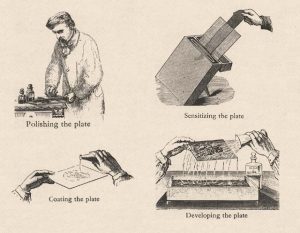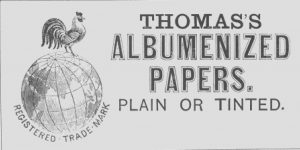 In 1851, Frederick Scott Archer invented a new photographic process to replace one-of-a-kind daguerreotypes on metal that were popular for portraits and multiple but imprecise calotypes made from paper negatives. The new process produced a clear negative on transparent glass that could be used to print multiple prints on paper. As its name implies,”wet-plate collodion” exposure and development of the negative had to be done within a ten-minute time frame while the light sensitive chemicals were wet, requiring photographers to bring portable darkrooms into the field. Although the process was capable of rendering fine detail within the shadows, the chemicals were sensitive only to blue light, making it impossible to render cloud-filled skies without exposing a separate negative only for the clouds. Because practical techniques for enlarging were not yet available, the glass negatives had to be the size of the finished print.
In 1851, Frederick Scott Archer invented a new photographic process to replace one-of-a-kind daguerreotypes on metal that were popular for portraits and multiple but imprecise calotypes made from paper negatives. The new process produced a clear negative on transparent glass that could be used to print multiple prints on paper. As its name implies,”wet-plate collodion” exposure and development of the negative had to be done within a ten-minute time frame while the light sensitive chemicals were wet, requiring photographers to bring portable darkrooms into the field. Although the process was capable of rendering fine detail within the shadows, the chemicals were sensitive only to blue light, making it impossible to render cloud-filled skies without exposing a separate negative only for the clouds. Because practical techniques for enlarging were not yet available, the glass negatives had to be the size of the finished print.
To achieve a large, or “mammoth,” print, a photographer required a glass negative of the same size, as well as a camera big enough to hold it. Thus photographing in places that were difficult to reach, like Yosemite Valley, meant hiking difficult terrain with mules loaded down with equipment, finding a source for water to rinse chemicals from plates, and a place to pitch a dark tent for working with poisonous and flammable materials. The sticky collodion solution would be carefully poured onto the clean glass, placed and exposed in the camera, developed in the dark, and finally fixed. Exposures required several seconds to several minutes, depending on the available light and the sensitivity of the chemicals.
 Once a photographer had completed work in the field to obtain glass negatives, back in the studio prints were made using paper with light-sensitive materials suspended in a solution of albumen, or egg white. These prints would then be adhered to a thick cardboard mount to keep from curling. Popular during the second half of the nineteenth century, albumen prints were made on paper coated with a solution of albumen (egg white) and sensitized with silver nitrate.
Once a photographer had completed work in the field to obtain glass negatives, back in the studio prints were made using paper with light-sensitive materials suspended in a solution of albumen, or egg white. These prints would then be adhered to a thick cardboard mount to keep from curling. Popular during the second half of the nineteenth century, albumen prints were made on paper coated with a solution of albumen (egg white) and sensitized with silver nitrate.
Used primarily with wet-plate collodion negatives and for a short time with dry-plate negatives, albumen prints have a characteristic sepia tone. The dried egg white provided a protective coating that enabled stereographs to be handled without becoming scratched and larger prints to be mounted into albums for frequent viewing.